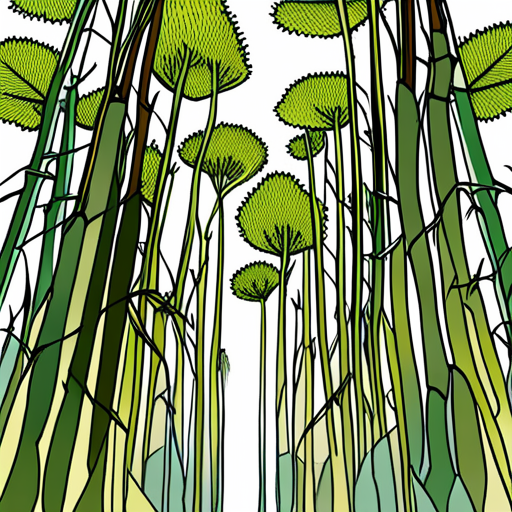Bamboo, renowned as nature’s fastest growing plant, possesses an extraordinary growth rate that surpasses that of any other plant on Earth. With certain species capable of reaching an astonishing growth rate of up to 91 cm per day, bamboo showcases a captivating and unparalleled ability to thrive in diverse environmental conditions.
This article explores the remarkable growth process of bamboo, delving into the factors that influence its growth and the methods to optimize its growth conditions. Understanding the intricacies of bamboo’s growth can shed light on the mechanisms that allow this plant to achieve such phenomenal growth rates.
By examining the impact of temperature, winds, sunlight, soil, water, and nutrition, we can gain insights into the complex interplay between these factors and bamboo’s growth. Furthermore, by considering the benefits of providing optimal growing conditions, such as well-drained soil, filtered sunlight, regular watering, and organic fertilization, we can uncover effective strategies to encourage and harness the incredible growth potential of bamboo.
Contents
- 1 Our Highlighted Points
- 2 The Growth Process
- 3 Factors Affecting Growth
- 4 Optimizing Growth Conditions
- 5 Frequently Asked Questions
- 5.1 What are some common uses for bamboo besides its rapid growth?
- 5.2 Are there any risks or downsides to growing bamboo in a garden or landscape?
- 5.3 Can bamboo be grown indoors or in containers?
- 5.4 How long does it take for bamboo to reach its maximum height?
- 5.5 Are there any specific care tips or techniques for promoting even faster growth in bamboo?
Our Highlighted Points
- Bamboo is known as the fastest growing plant on Earth.
- There are over 1400 species of bamboo, each with different growth rates.
- Factors such as temperature, winds, sunlight, soil, water, and nutrition influence the growth rate of bamboo.
– Some of the fastest growing bamboo species include Bambusa oldhamii, Phyllostachys edulis, and Phyllostachys bambusoides.
The Growth Process

The growth of bamboo is influenced by various factors such as temperature, winds, sunlight, soil, water, and nutrition, which can determine the rate at which it grows.
One important aspect of bamboo growth is the role of cell division. Bamboo exhibits a higher level of coordination between cell division, growth, and cell wall biosynthesis, which allows for its rapid growth. This efficient cell division process contributes to the plant’s ability to grow quickly and continuously.
Additionally, pruning plays a significant role in bamboo growth rate. By removing older and dead culms, energy is diverted into producing new shoots, encouraging rapid growth. Pruning also helps maintain the overall health and vitality of the plant.
By understanding these factors and implementing proper care techniques such as pruning, bamboo growth can be optimized and accelerated.
Factors Affecting Growth

Factors such as temperature, winds, sunlight, soil, water, and nutrition play a crucial role in influencing the growth rate of different bamboo species. The growth rate of bamboo can be maximized by considering these factors:
- Temperature: Bamboo thrives in warm climates, with optimal growth occurring between 60°F and 95°F.
- Winds: Strong winds can damage bamboo, so providing some protection through windbreaks or planting in a sheltered area is important.
- Sunlight: Most bamboo species require at least 4 hours of filtered sunlight to grow properly.
- Soil: Bamboo prefers well-drained, light loamy soil with high organic content. The soil should be kept moist but not waterlogged.
- Water and Nutrition: Regular watering is essential, especially during the first season and during drought or heat for established plants. Fertilizing with an organic slow-release fertilizer can accelerate growth.
By understanding and optimizing these factors, bamboo growers can create the ideal conditions for maximizing the growth potential of their bamboo plants.
Optimizing Growth Conditions

To enhance the growth potential of bamboo, it is essential to create optimal conditions through careful consideration of temperature, sunlight, soil quality, water availability, and nutrient supply. Bamboo thrives in well-drained, light loamy soil with high organic content. It requires at least 4 hours of filtered sunlight, although some species can tolerate partial shade. Watering is crucial, especially during the first season and during drought or heat for established plants. Drought tolerance in bamboo is influenced by factors such as species selection, root mass development, and the ability to withstand prolonged periods of no water.
Fertilizing with an organic slow-release fertilizer can accelerate growth by a year. Mulching with materials like sawdust or compost not only protects the rhizomes but also provides additional nutrients. Pruning older and dead culms is another important technique to encourage rapid growth. By diverting energy into producing new shoots, pruning helps the plant grow more vigorously. A summary of the benefits of mulching and pruning techniques is presented in the following table:
| Mulching Benefits | Pruning Techniques |
|---|---|
| Protects rhizomes | Encourages new shoots |
| Provides nutrients | Diverts energy |
| Retains soil moisture | Promotes vigorous growth |
Frequently Asked Questions
What are some common uses for bamboo besides its rapid growth?
Common uses for bamboo include construction materials, such as flooring, furniture, and scaffolding. It is also used in the production of various products and crafts, such as paper, textiles, musical instruments, kitchenware, and decorative items. Even bamboo hairbrushes offer several advantages that promote healthy and beautiful hair.
Are there any risks or downsides to growing bamboo in a garden or landscape?
The environmental impact of bamboo cultivation is generally positive, as it is a fast-growing plant with high carbon sequestration capabilities. However, there are potential risks of bamboo invasion in natural ecosystems if it is not properly contained and managed.
Can bamboo be grown indoors or in containers?
Growing bamboo indoors or in containers presents challenges and benefits. Choosing the right bamboo variety is crucial for successful container gardening. Factors such as size, growth rate, and maintenance requirements should be considered to ensure optimal growth in an indoor or container environment.
How long does it take for bamboo to reach its maximum height?
The time it takes for bamboo to reach its maximum height varies depending on factors such as species, growth conditions, and age. Some bamboo species can grow up to 2 to 3 feet per day, while others grow at a slower rate of 1 to 5 feet per year.
Are there any specific care tips or techniques for promoting even faster growth in bamboo?
Bamboo care techniques for promoting faster growth include providing optimal growing conditions, such as well-drained soil, filtered sunlight, and regular watering. Fertilizing with organic slow-release fertilizer and mulching with sawdust or compost can also accelerate growth. Pruning older culms diverts energy into new shoots.

